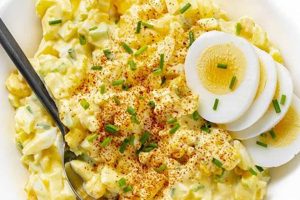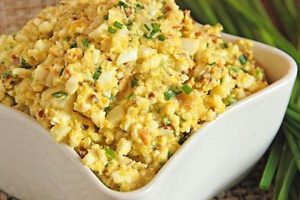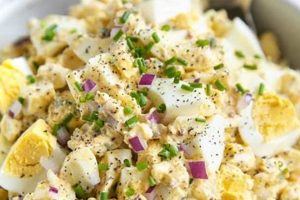A blend of cooked eggs, cottage cheese, and optional additions like mayonnaise, mustard, vegetables, or herbs creates a protein-rich, creamy salad. This dish offers a versatile base, adaptable to various flavor profiles through the inclusion of spices, seasonings, and other ingredients. It can be enjoyed as a sandwich filling, a light lunch, or a component of a larger meal.
This culinary combination provides a substantial source of protein and calcium, contributing to a balanced diet. Its adaptability makes it a suitable option for diverse palates and dietary needs, including those seeking low-fat or gluten-free alternatives. Historically, similar combinations of dairy and eggs have appeared in various cultures’ cuisines, demonstrating the enduring appeal of this simple yet nutritious pairing. The modern iteration with cottage cheese offers a lighter, tangier twist on traditional egg salad.
The following sections will delve into variations of this dish, including specific recipes, nutritional information, tips for preparation and storage, and creative serving suggestions.
Tips for Preparing Cottage Cheese Egg Salad
Optimizing ingredient selection and preparation techniques enhances the overall quality and flavor profile of the dish.
Tip 1: Egg Cooking Technique: Achieving perfectly cooked eggs is crucial. Overcooked eggs can become rubbery, while undercooked eggs present food safety concerns. Steaming or boiling eggs to a firm, yet moist yolk is recommended.
Tip 2: Cottage Cheese Selection: Different cottage cheese varieties offer varying textures. Small curd cottage cheese provides a smoother consistency, while large curd cottage cheese adds a more textured element. Low-fat or non-fat versions can reduce the overall calorie and fat content.
Tip 3: Mayonnaise and Mustard Balance: The ratio of mayonnaise to mustard significantly influences the flavor profile. A higher proportion of mustard adds a sharper, tangier flavor, while more mayonnaise results in a richer, creamier texture.
Tip 4: Incorporating Fresh Herbs: Fresh herbs, such as chives, dill, or parsley, can elevate the flavor complexity. Adding herbs at the end of preparation preserves their vibrant flavor and color.
Tip 5: Vegetable Additions: Incorporating finely chopped vegetables like celery, red onion, or bell peppers adds textural contrast and nutritional value.
Tip 6: Seasoning Considerations: Seasoning with salt, pepper, and other spices enhances the overall flavor profile. Paprika, garlic powder, or onion powder can complement the other ingredients.
Tip 7: Chilling and Serving: Chilling the salad for at least 30 minutes allows the flavors to meld. Serve chilled on bread, crackers, lettuce cups, or as a stand-alone dish.
By following these tips, one can create a flavorful and nutritious egg salad. Attention to detail, from ingredient selection to chilling time, ensures an optimal culinary experience.
These preparation guidelines provide a foundation for creating a consistently delicious and satisfying dish. The following section will offer variations and serving suggestions.
1. Ingredients
Ingredient selection significantly impacts the final flavor, texture, and nutritional value of cottage cheese egg salad. Understanding the role of each component allows for informed choices regarding taste preferences and dietary needs.
- Eggs
Hard-boiled eggs provide the foundational protein and structure. The cooking method influences the egg’s texture; overcooking results in a rubbery consistency. Fresh, high-quality eggs contribute optimal flavor and richness. The number of eggs used determines the salad’s overall richness and heartiness.
- Cottage Cheese
Cottage cheese contributes a creamy texture and tangy flavor. Different curd sizes (small, large, or whipped) offer varying textural experiences. Low-fat or non-fat versions reduce overall fat and calorie content. The amount of cottage cheese influences the salad’s lightness or richness.
- Mayonnaise/Dressing
Mayonnaise adds creaminess and richness. Alternatives like Greek yogurt or avocado mayonnaise offer lighter, healthier options. Mustard contributes tang and complexity. The ratio of mayonnaise to mustard balances richness and sharpness.
- Flavor Enhancers
Fresh herbs (chives, dill, parsley) contribute brightness and aromatic complexity. Spices (paprika, garlic powder, onion powder) offer savory depth. Chopped vegetables (celery, red onion, bell pepper) provide texture and nutritional value. These additions contribute to the salad’s overall flavor profile and nutritional density.
Careful consideration of these ingredients allows for customization and optimization of the cottage cheese egg salad, aligning it with individual dietary preferences and desired flavor profiles. The interplay of these components ultimately determines the dish’s success.
2. Preparation Method
The preparation method significantly influences the final quality, texture, and flavor profile of cottage cheese egg salad. A systematic approach ensures consistent results and maximizes the potential of the ingredients.
- Egg Cooking Technique
Proper egg cooking is paramount. Overcooked eggs become rubbery and dry, while undercooked eggs pose food safety risks. Methods like steaming or boiling achieve optimal consistency. Steaming often yields a more tender, evenly cooked egg white, while boiling allows for precise timing. The chosen technique directly impacts the egg’s texture within the salad.
- Ingredient Incorporation
The order and method of ingredient incorporation affect the final product. Combining the cottage cheese and mayonnaise before adding the chopped eggs prevents over-mashing the yolks and maintains a desirable texture. Gentle folding preserves the integrity of the ingredients. Alternatively, some prefer a smoother, more emulsified texture achieved through more vigorous mixing.
- Seasoning and Flavor Adjustment
Seasoning should occur incrementally. An initial addition of salt and pepper, followed by tasting and further adjustment, prevents over-seasoning. Incorporating fresh herbs and spices after the primary ingredients are combined preserves their delicate flavors and aromas. This staged approach allows for nuanced flavor development.
- Chilling and Resting
Chilling the prepared salad allows the flavors to meld and deepen. A minimum of 30 minutes in the refrigerator enhances the overall flavor profile. This resting period allows the ingredients to harmonize, creating a more cohesive and flavorful experience.
These methodological steps contribute significantly to the overall success of the cottage cheese egg salad. Attention to detail in each stage, from egg cooking to chilling, elevates the dish from a simple mixture to a carefully crafted culinary creation. The resulting salad benefits from a balanced flavor profile and a pleasing texture derived from considered preparation techniques.
3. Nutritional Value
Nutritional value represents a key consideration within any dietary context, and cottage cheese egg salad recipes offer a profile worth examining. This analysis will explore the macronutrient composition, vitamin and mineral content, and potential health benefits associated with this dish.
- Macronutrient Profile
Cottage cheese egg salad provides a significant source of protein, primarily from the eggs and cottage cheese. Protein plays a crucial role in muscle building, tissue repair, and overall bodily function. The fat content can vary depending on the type of cottage cheese and the amount of mayonnaise or other added fats. Opting for low-fat cottage cheese and reducing added fats lowers the overall fat content. Carbohydrates contribute minimally to the overall macronutrient profile, making this a suitable option for individuals following low-carbohydrate diets. The specific macronutrient ratios can be adjusted based on ingredient choices and portion sizes.
- Vitamin and Mineral Content
This dish offers a valuable source of certain vitamins and minerals. Eggs are rich in choline, an essential nutrient for brain health and nerve function. Cottage cheese contributes calcium, vital for bone health and other physiological processes. Selenium, an antioxidant present in eggs, supports cellular health. The combined vitamin and mineral profile contributes to overall nutritional well-being.
- Satiety and Weight Management
The high protein content in cottage cheese egg salad contributes to feelings of satiety, potentially aiding in weight management efforts. Protein promotes fullness, which can help regulate calorie intake. The fiber content, while relatively low, can be increased by incorporating vegetables like celery or bell peppers, further enhancing satiety.
- Dietary Considerations
This dish can be adapted to fit various dietary needs. Individuals following gluten-free diets can enjoy it as a safe and nutritious option. Adjusting the ingredients can cater to low-fat or low-sodium dietary restrictions. For example, using low-fat cottage cheese and reducing added salt can create a healthier version without compromising flavor or satisfaction.
The nutritional composition of cottage cheese egg salad makes it a valuable addition to a balanced diet. Its adaptable nature allows for modifications to suit individual dietary requirements and preferences, further enhancing its versatility as a healthy and enjoyable meal option.
4. Serving Suggestions
Serving suggestions enhance the versatility of cottage cheese egg salad, extending beyond the traditional sandwich filling. Exploration of various serving methods demonstrates the adaptability of this dish within different meal contexts and culinary styles.
- Sandwiches and Wraps
Classic sandwich preparations utilize various breads, from whole wheat to sourdough, offering textural and flavor contrasts. Wraps, using tortillas or lavash, provide a convenient and portable option. Incorporating lettuce, tomato, or spinach adds freshness and nutritional value. The choice of bread or wrap influences the overall sensory experience.
- Salads and Bowls
Cottage cheese egg salad can serve as a substantial component within green salads or grain bowls. A bed of mixed greens topped with the salad provides a light yet protein-rich meal. Incorporating quinoa or brown rice adds complex carbohydrates and fiber. This approach offers a balanced and nutritious meal option.
- Stuffed Vegetables or Avocado Halves
Utilizing halved tomatoes, bell peppers, or avocados as vessels creates visually appealing and flavorful presentations. These options cater to those seeking lower-carbohydrate alternatives or visually interesting presentations. The natural flavors of the vegetables complement the egg salad filling.
- Crackers and Appetizers
Serving the egg salad on crackers or crudits provides a convenient appetizer or snack option. This approach suits casual gatherings or light meals. The crispness of the crackers or vegetables contrasts with the creamy texture of the salad.
These varied serving suggestions demonstrate the adaptability of cottage cheese egg salad within diverse culinary applications. From simple snacks to substantial meals, the dish offers a versatile and nutritious option, adaptable to individual preferences and dietary needs. Consideration of these serving methods expands the potential of this classic dish beyond traditional expectations.
5. Flavor Variations
Flavor variations represent a crucial aspect of cottage cheese egg salad recipes, offering adaptability and personalized culinary experiences. The inherent neutrality of the base ingredientseggs and cottage cheeseprovides a blank canvas for diverse flavor profiles. Strategic ingredient incorporation allows for customization based on individual preferences, dietary restrictions, or desired culinary styles. This flexibility distinguishes cottage cheese egg salad as a versatile dish adaptable to various palates and occasions. For example, incorporating curry powder and chopped chutney transforms the salad into an Indian-inspired dish, while the addition of smoked paprika and diced pickles creates a smoky, savory profile.
Understanding the impact of specific ingredients on the final flavor profile allows for informed choices during recipe development. Fresh herbs like dill, chives, or parsley contribute bright, herbaceous notes. Spices such as paprika, cumin, or cayenne pepper introduce varying degrees of heat and complexity. Incorporating ingredients like chopped vegetables (celery, red onion, bell pepper), dried fruits (cranberries, raisins), or nuts (walnuts, pecans) adds textural contrast and nuanced flavor dimensions. The interplay of these additions creates a symphony of flavors, elevating the dish beyond its basic components.
Systematic experimentation with different flavor combinations unlocks the full potential of cottage cheese egg salad. Balancing contrasting flavors, such as sweet and savory or spicy and tangy, creates depth and complexity. Consideration of regional culinary traditions can inspire unique flavor profiles, expanding the range of possibilities. Ultimately, exploring flavor variations transforms cottage cheese egg salad from a simple staple into a dynamic and customizable culinary creation, suitable for a wide array of dining experiences. This adaptability reinforces its value as a versatile and adaptable recipe.
Frequently Asked Questions
This section addresses common inquiries regarding cottage cheese egg salad recipes, providing clear and concise information to facilitate successful preparation and enjoyment.
Question 1: How long can cottage cheese egg salad be stored safely?
Properly stored in an airtight container in the refrigerator, it typically remains safe for consumption for three to five days. Spoilage indicators include a sour odor, discoloration, or changes in texture.
Question 2: Can this recipe be adapted for individuals with lactose intolerance?
Lactose-free cottage cheese can be substituted, allowing those with lactose intolerance to enjoy this dish. Alternatively, replacing cottage cheese with Greek yogurt or avocado offers a dairy-free alternative.
Question 3: What are effective methods for reducing the overall fat content?
Utilizing low-fat or non-fat cottage cheese, reducing the amount of mayonnaise, and incorporating Greek yogurt as a partial replacement for mayonnaise effectively lowers the fat content.
Question 4: How can one achieve perfectly cooked hard-boiled eggs for this recipe?
Steaming or boiling eggs until the yolks reach a firm yet moist consistency is recommended. Overcooking leads to a dry, rubbery texture. Immediate cooling in ice water prevents the formation of a greenish ring around the yolk.
Question 5: Beyond sandwiches, what are some creative ways to serve cottage cheese egg salad?
It can be served as a salad topping, a filling for stuffed vegetables (tomatoes, avocados, bell peppers), or as a dip with crackers or crudits. It also complements grain bowls or serves as a light meal on its own.
Question 6: Can the recipe be prepared in advance for meal prepping?
Preparing the salad a day or two in advance is convenient for meal prepping. Store it in an airtight container in the refrigerator to maintain freshness and prevent flavor contamination. Add fresh herbs or crunchy vegetables just before serving to maintain their texture and vibrancy.
Addressing these common questions provides clarity and guidance for preparing and enjoying cottage cheese egg salad. Understanding these aspects contributes to a successful culinary experience.
The subsequent section will offer a collection of specific recipes showcasing the versatility of cottage cheese egg salad.
Conclusion
Exploration of cottage cheese egg salad recipes reveals a versatile and nutritious dish adaptable to various dietary needs and flavor preferences. From ingredient selection and preparation methods to nutritional value and serving suggestions, the analysis provides a comprehensive understanding of this culinary creation. Key factors highlighted include the importance of proper egg cooking techniques, the impact of cottage cheese variations on texture, and the role of flavor enhancers in creating diverse flavor profiles. The adaptability of this dish, demonstrated through various serving suggestions and flavor variations, positions it as a valuable component within a balanced and adaptable dietary repertoire.
Cottage cheese egg salad offers a readily available, customizable, and nutritionally sound meal option. Further exploration of flavor profiles and creative presentations can elevate this simple dish to new culinary heights. Continued experimentation promises exciting possibilities within the realm of healthy and enjoyable cuisine.






